
The Lygaeoidea are a sizeable superfamily of true bugs, containing seed bugs and allies, in the order Hemiptera. There are about 16 families and more than 4,600 described species in Lygaeoidea, found worldwide. Most feed on seeds or sap, but a few are predators.

The Lygaeidae are a family in the Hemiptera, with more than 110 genera in four subfamilies. The family is commonly referred to as seed bugs, and less commonly, milkweed bugs, or ground bugs. However, while many of the species feed on seeds, some feed on sap (mucivory) or seed pods, others are omnivores and a few, such as the wekiu bug, are carnivores that feed exclusively on insects. Insects in this family are distributed across the world. The family was vastly larger, but numerous former subfamilies have been removed and given independent family status, including the Artheneidae, Blissidae, Cryptorhamphidae, Cymidae, Geocoridae, Heterogastridae, Ninidae, Oxycarenidae and Rhyparochromidae, which together constituted well over half of the former family.

Rhaphigaster nebulosa, common name mottled shieldbug, is a species of stink bugs in the family Pentatomidae. It is the only species of the genus Rhaphigaster.

Nabis flavomarginatus is a species of damsel bug in the family Nabidae.

Nabis limbatus is a species of damsel bug in the family Nabidae. It is found in Northern Europe and the northern part of Western and Central Europe. It occurs in the East in Eastern Europe and across the Palearctic to Siberia to China and Korea. It is introduced in Canada. In the Alps, it rises to about 1400 meters above sea level. In the South of Europe, it is found only in the central uplands.

Gonocerus acuteangulatus is a herbivorous species of true bug in the family Coreidae. It is commonly known as the box bug in the UK as it once only occurred in Box Hill in Surrey where it fed on box trees.

Neides tipularius is a Palearctic stilt bug. It occurs from the Northern Mediterranean to Scandinavia and the British Isles. Further east it is found in Asia minor and the Caucasus to Central Asia. In Germany and the Alps it is widespread and not uncommon. In Britain it is locally common in large parts of the South. In Ireland it is rare.

Chartoscirta elegantula is a Palearctic shore bug widespread in marshes or at the margins of rivers and lakes. Adult length is 3.5-4.0 mm. It is an agile ambush predator of small invertebrates on the ground or in peat moss. The adult animals hibernate often far from their summer habitats in dry material on the ground in moss or dry leaf litter.
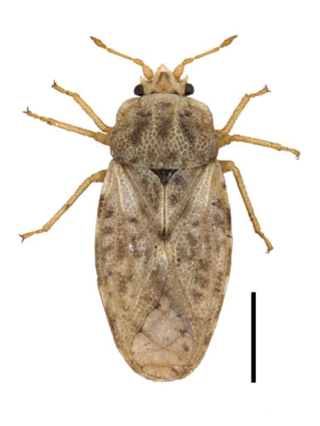
Piesma maculatum is a true bug species found from North Africa to southern parts of Scandinavia and the South of the British Isles then across the Palearctic to the Black Sea region to Central Asia, China and Japan. In Central Europe it is widespread and generally the most common species of the family Piesmatidae.

Metatropis rufescens is a species of true bugs. The species is found in Europe, with the exception of the far North and South then East to the Black Sea region and across the Palearctic to Siberia. In Central Europe it is common, but it is not found everywhere. In the British Isles it is common in the South including Wales and Ireland. It occurs in shady, mostly moist habitats in deciduous forests.

Aradus depressus is a true bug in the family Aradidae. The species is found in the Palearctic from Ireland East to Siberia. In the Southeast, the range extends to the Caucasus mountains. A. depressus is the most common species of the genus Aradus and can be found everywhere. In the Alps it occurs up to 1,600 metres (5,200 ft).
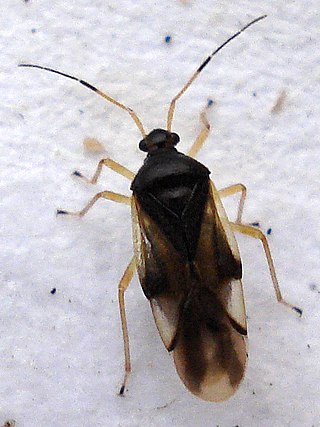
Bryocoris pteridis is a true bug in the family Miridae. The species is found in Europe from Ireland in the West and including the northern edge of the Mediterranean and the East across the Palearctic to Siberia.In Central Europe, it is widespread and occurs both in the central uplands and the Alps up to 1500 metres above sea level.

Monalocoris filicis is a true bug in the family Miridae. The species is found in Europe from Ireland in the West and including the northern edge of the Mediterranean and the East across the Palearctic to Central Asia, Korea and Japan. In Central Europe, it is widespread and generally common. In the Alps, it occurs up to the edge of the forest. Habitats are deciduous and coniferous forests and moist, open habitats such as bogs or the shores of streams.
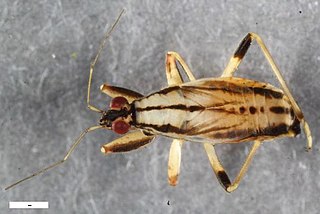
Himacerus boops is a species of damsel bug in the family Nabidae. It is found from South Scandinavia and the South of the British Isles over Western and Central Europe and East across the Palearctic to Siberia and in the Caspian region. They are not present in most parts of the Mediterranean.
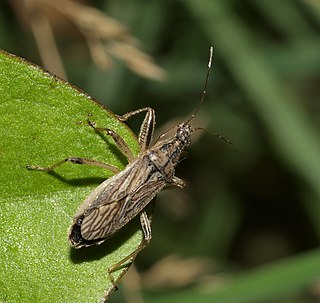
Himacerus major is a species damsel bug in the family Nabidae. It is found in the Holarctic. The range is from South Scandinavia and the South of the British Isles over West Europe including the Western Mediterranean, Central Europe and Eastern Europe and in the Caucasus. It is also found in North America. Himacerus major occurs in many different habitats with grass, regardless of the level of humidity. The species occurs on very dry dune habitats, and nutrient-poor grasslands,as well as wet shores of waters without woody vegetation and salt places inland. The species occurs in very large numbers near the coast of the Northern Baltic Sea. It is absent from woodland.
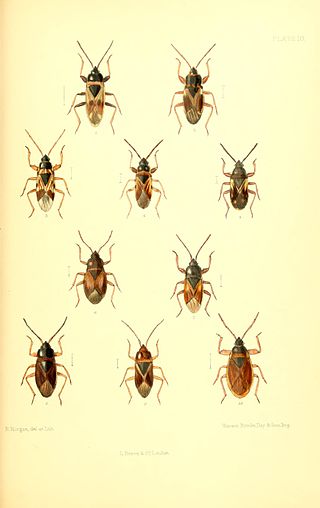
Taphropeltus contractus is a species in the family Lygaeidae. It is found in the West Palearctic - in Europe, excepting the far North. In the South of Europe the distribution includes the Mediterranean Basin including North Africa. The East limit is the Caucasus. In Central Europe the species is widespread and it is not uncommon in the South. North of the central uplands, it occurs but only locally. The species occurs only in warmer in the Alps. It prefers half shady, dry warm habitats.

Rhyparochrominae is a subfamily of dirt-colored seed bugs in the family Rhyparochromidae. There are more than 410 genera and 2,000 described species in Rhyparochrominae.

Blepharidopterus angulatus, the black-kneed capsid, is a species of plant bug in the family Miridae. It is found in North Africa, Europe East across the Palearctic to Central Asia and in North America.

Megalonotus praetextatus is a species of seed bug in the family Rhyparochromidae.

Piesma is a genus of ash-grey leaf bugs, insects of the family Piesmatidae. It is the type genus of the family.




















